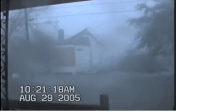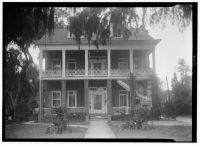If you’re a weather-watcher like I am (remember that back when this blog started in 2009, one of its major themes was Hurricane Katrina–its losses and its preservation success stories), you’ve spent quite a bit of time over the past week glued to images of Hurricane Michael popping up in the Gulf of Mexico and speeding straight into the Florida Panhandle, Georgia, and beyond. Once the pictures and video of devastation started coming out of Panama City, Mexico Beach, and Port St. Joe, it’s become clear that Michael caused Katrina-level damage to those communities, a comparison I had never hoped to make for the Florida beaches I’ve been haunting since childhood.
It’s been hard to get a sense of the overall level of damage from the news and Facebook reports, but as with Katrina, one of the best sources of information is the NOAA (National Oceanic and Atmospheric Administration) high-resolution aerial images taken over the last few days that allow you to scan up and down the Florida coast and into inland communities that experienced Michael’s severe winds, such as Tallahassee, Marianna, and Bainbridge, Georgia. You can zoom way in to see houses and hotels with their roofs sheared off (my initial thought is that there is much more wind damage from Michael than there was in Katrina, but its surge wasn’t as devastating as Katrina’s), houses that clearly floated somewhere they weren’t originally, and many, many empty lots in Mexico Beach.
The best summation of my feelings in the last 4 or 5 days has come from Marshall Ramsey in his Clarion-Ledger commentary “An open letter to those affected by Hurricane Michael.”
The shock will fade eventually and then you have to get to work. You’ll figure out quickly if you have enough insurance or if it covers your damage. (Sadly, many of us don’t check our policies until disaster strikes.) The weather will be eerily calm after the storm — at least outside. Inside your head, it will continue to storm. We know.
You will feel very, very alone.
Here’s the good news. You aren’t.
Like the end of the movie “Field of Dreams,” there will be long lines of vehicles with volunteers coming to help. Vans full of chainsaws and casseroles will pull into your cities and towns — to cut the trees off your house and to feed you. Power trucks will pour in as soon as the wind dies down. And like the heroes they are, linemen will perform amazing feats as they get your power back on. We can tell you from experience — a power truck is like an ice cream truck for grownups.
. . . .
The government will do its best to help (hopefully). There will be aid in the form of water, loans, money and labor. But when things fall through the cracks (and they will), faith-based and volunteer organizations will pick up the slack. We discovered that first-hand, too. In fact, we couldn’t have gotten back on our feet without their help. It was truly faith jumping off the pages into practice. Even today, we are deeply grateful for all the people who came to our rescue in our time of need.
We’ll keep you updated on historic resources affected by Michael and ways you can help.
More about hurricanes . . .
Categories: Disasters










Does anyone recall that those MSU Cow College engineers at MDOT ordered the felling of live oaks along Highway 90 after Katrina… claiming that the trees were dead because the leaves had turned brown? Obviously, Agronomy I at State is only an elective for Civil Engineers. I never knew that the cotton plant was an annual plant until I took that course. There are still unpicked irrigated cotton in the fields in the Prairie and the wet soil, combined with the rich nitrogen soils( after years of growing legumes) and the warm weather have caused the cotton to regenerate new growth after the defoliant was flown at the beginning of the harvest season.
I still claim that Web Heidelberg’s favorite Alamo Plaza motel on the Coast survived Hurricane Katrina only to be trashed by the badge-flashing, gang-busting agents of Homeland Security.
Malvaney disagrees.
LikeLike
I meant to claim that I didn’t know that the cotton plant is NOT an annual but a perennial.
Yes, what you saw was a cotton plant that never went through a freeze.
LikeLike
I stayed at the Alamo Courts once as a youngster…..a couple of friends and I took a quick trip to the “beach” and were poor as could be. That was all we could afford. But we had fun…our first trip alone.
When I was in St. Maarten a few years ago, they pointed out a “cotton tree” on a tour we took. Is that the same as a cotton plant? Maybe one that’s been left alone?
Is there a website that shows the houses along the coast before Camille and “progress”?
LikeLike
I meant to claim that I didn’t know that the cotton plant is NOT an annual but a perennial.
Yes, what you saw was a cotton plant that never went through a freeze.
LikeLike
Even the wealth stayed there, too.
Web’s say at the Inn:
https://webheidelberg.com/2013/05/27/my-night-at-the-alamo-plaza/
LikeLike
I have to say I don’t remember a whole lot about it. We drove all night because we couldn’t afford more than 2 days hotel, got to the beach that morning and changed in a gas station bathroom, stayed at the beach all day and drank beer, then found a room. We didn’t even eat all day, we were so broke. I think we had McDonald’s for supper. We were driving a 20 year old Impala that used 4 tanks of gas in 2 days.
I remember there was a double bed for all 3 of us, and a shower made for a short person. I had to bend my knees to wash my hair. It seems like there was a little crescent moon shaped glass in the door so you could see out—or maybe it was in the bathroom door. There was a frosted glass window in the bathroom. This was pre-casino days, and you only had to be 18 to buy beer too.
I don’t remember seeing a pool at all. But I was the least sober of the 3.
Did it survive Katrina and then was demolished?
LikeLike
Malvaney remembers that the Alamo Plaza was destroyed by Katrina. I recall that it survived only to be sacrificed in a hostage-taking/ siege exercise conducted by the gun-wielding Homeland Security Popo. However, it had already been marked for demolition prior to Katrina in the name of “progress” peddled by the Zoot-suited land developers on the Coast
LikeLike
With apologies to Malvaney:
The FBI exercise at the Alamo Plaza occurred in 2003.
http://www.wlox.com/story/1100993/fbi-team-trains-at-old-gulfport-motel/
LikeLike